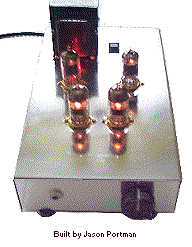
An Output Transformerless Tube Headphone Amplifier
by Kurt Strain

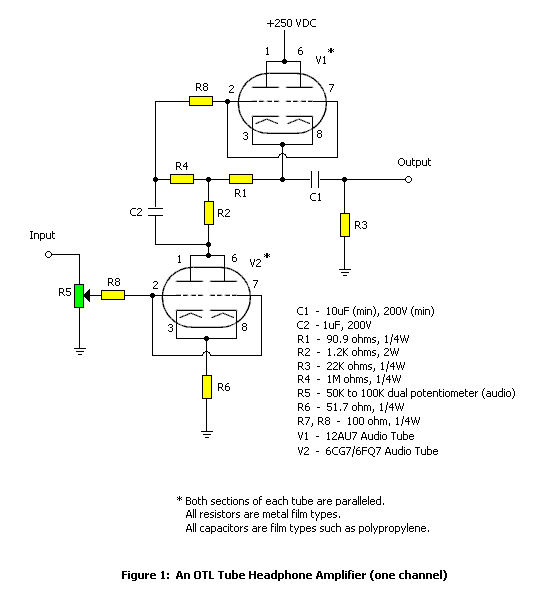
The tube headphone amplifier in figure 1 is a high current mu follower, with a 12AU7 cathode follower driven by a 6CG7. Both sections of each tube are paralleled to minimize noise. It's a zero global feedback, OTL design of pretty high quality. I use it and like it for Grado, Sennheiser, and Sony headphones. The maximum gain is about 25 dB with the 6CG7, so it pays to watch the attenuator level. R5 and R6 total 20K ohms as a stepped attenuator. A log pot of 20K to 100K ohms would be a good substitute. This design can be used as a line preamp as well.
The power output depends a lot on headphone impedance. The circuit has significant output impedance (something like 500 ohms) which some headphones don't mind, some do. It will put out around 20 mA peak current. The output impedance is pretty much constant and independent of load, but any tube changes will greatly affect it.
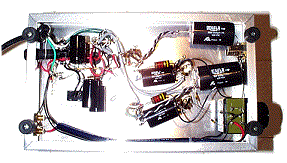
Layout is crucial to avoid motorboat oscillation due to parallel operation. Short wires across tube pins help this, and have them cross each other perpendicularly. Once the oscillation is gone, it stays gone. If this problem persists, separate cathode resistor R7 into 2 cathode resistors, 100 ohms each to ground, and add 100 ohm plate resistors to V1 on each side, to B+. This will isolate the mismatch between units better and prevent a bistable bias condition.
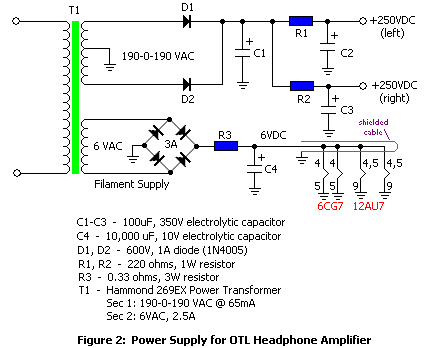
Both channels run off a well-filtered 6VDC, 2.5A filament supply and a 250VDC supply with separate filter capacitors for each channel to minimize hum and crosstalk (figure 2). The supplies don't need to be regulated. The 12AU7 will take the raised cathode potential so you don't need to raise the voltage of the filament supply above ground level. The Hammond 269EX power transformer works very well in this application and can be obtained from Angela Instruments.
Use shielded twin lead to wire the filaments. Run one lead to each tube separately from the transformer to keep current on the line at a minimum. Keep the filament wire away from the signal and DC power supply wires. Also, keep the power supply away from the amplifier circuit, especially V2.
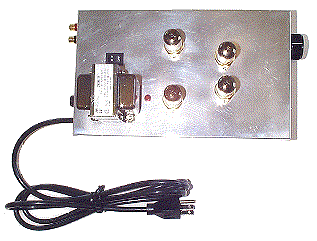
The way I built it was to put it in an enclosed box that's about 7" wide by 4.5" tall by 12" deep with vented covers. The inside has a deck with cut-outs for tubes and wires and caps. It is light and compact (weighs about 10 lbs). [Editor: The amplifier shown above was built by Jason Portman, and uses an 8" x 11" aluminum chassis from Hammond, which he polished before constructing the amplifier.]
This headphone amp sounds very good with the Sony MDR series. I have found that even though the Grado's are a low impedance load, they don't really require a low impedance amp to sound good if the amp works out synergistically.
For Sennheiser 580 headphones, the amp will not put out as much bass definition and detail as other circuits could. The Sennheisers tend to sound soft, so a little tighter amp seems to help. The Grados tend to sound sharper, and so the highish output impedance OTL seems to soften it to where I liked it.
Addendum
12/8/98: Revised power supply (figure 2) for improved ripple rejection and channel isolation.
5/3/99: V2 changed from 6922 to 6CG7/6FQ7 for improved stability. The 6CG7/6FQ7 is pin-for-pin compatible with the 6922 and no other circuit changes are required. The author advises that this substitution be made for existing builds because the 6CG7/6FQ7 tube is better able to handle the power dissipation of the circuit and will last longer.
Also upgraded filament power supply (figure 2) from AC to DC for reduced hum and greater stability.
5/21/99: Added pictures of OTL amplifier built by Jason Portman.
5/25/99: Ole W. Saastad built this version of the OTL amplifier:
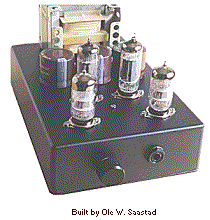
It runs off a 330V supply, which necessitated changing R2 to 5.6K ohms, 2W. The 6VDC filament supply is regulated with 7806 regulators. All instructions, including a chassis drilling guide and parts layout, can be found at http://www.uio.no/~olews/otl/otl.html.
7/16/99: Revised volume control in figure 1.
1/14/00: Jason Portman writes:
The OTL is now fully tweaked and working beautifully. In fact after the conversion to DC heaters it was MUCH MORE STABLE! I have been experimenting with 3 different front end tubes. The 6CG7, 6FQ7 and my favorite, the Svetlana 6N1P. The GE 6CG7's with "white" logo seen second best in terms of level and sound quality. The 6N1P's are really much better though; they are much less muddy than the 6CG7's, have better low end, better imaging and much more transparent. Also an added benefit of their 300ma heaters is they glow quit nicely!
7/15/00: Eduard Orvisky built this headphone amplifier using ideas from Kurt Strain's and Eric Barbour's designs. It uses two 6SN7s in the mu follower (R2 is increased to 2K, 2W), and solid state and rectified heaters (he also tried a 5Y3 tube rectified supply, but preferred the solid state version for its faster sound). More details of this design can be found on his website.
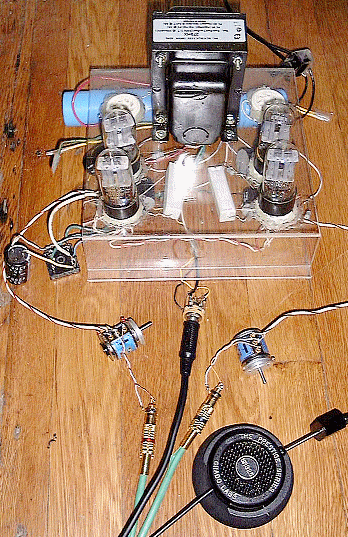
9/1/00: Eduard Orvisky moved his amp to a new chassis and gave it a stunning paint job. He writes: "I sprayed it matte black in the beginning, but did not like it. Did not look bad, but it was too obvious. Then I tryed silver metallic. That was worse, not as real polished metal. Then I painted acrylic sapphire blue on it. With brush, hence the strokes."
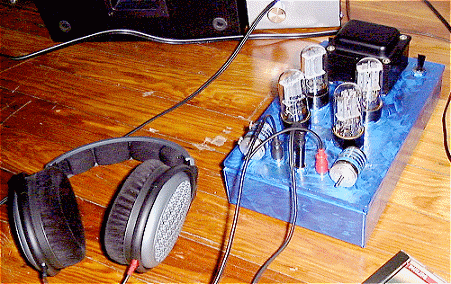
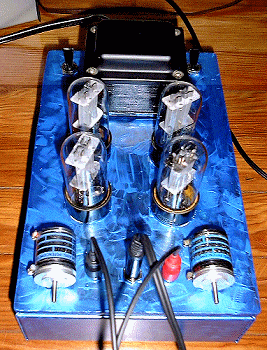
c. 1998, 1999 Kurt Strain.
Author's website: Tube Odd-e-o-file Page.